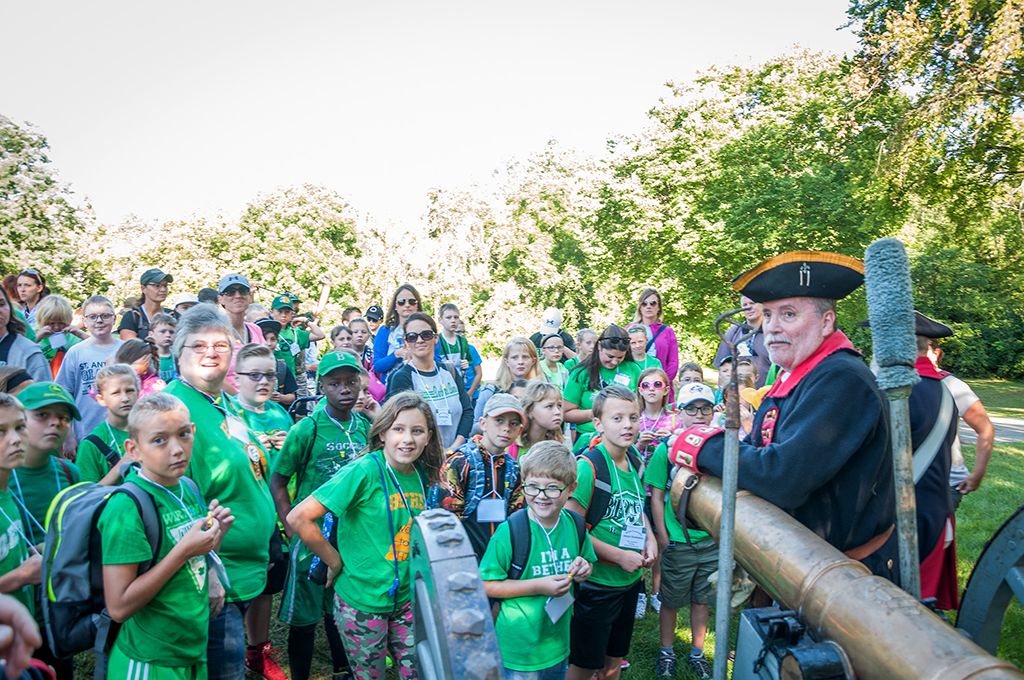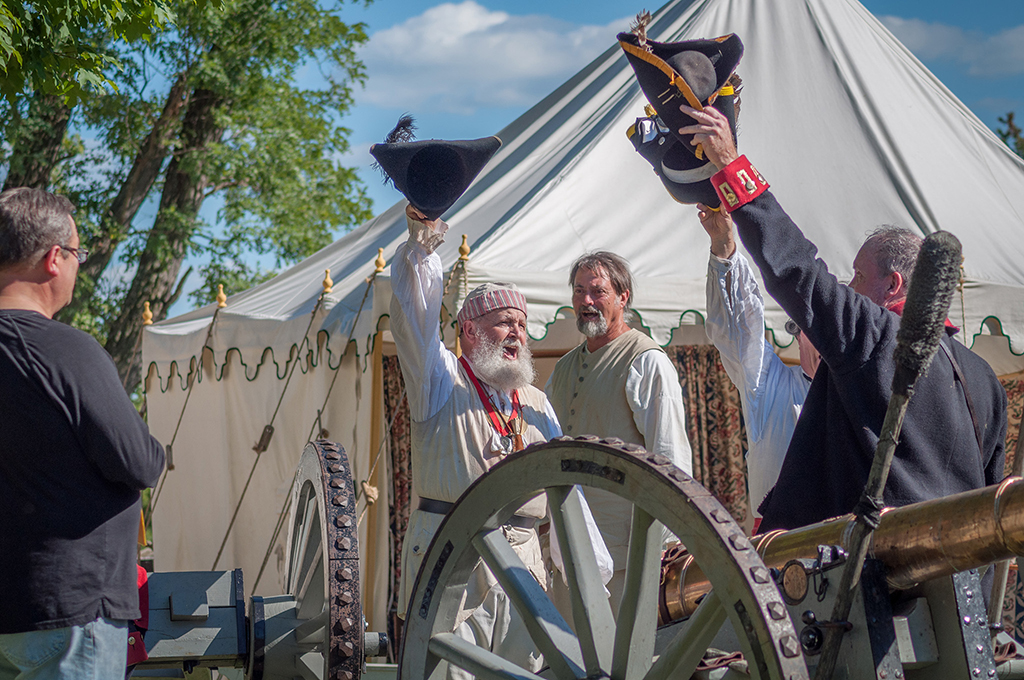Saturday marked the 34th year of the Fair at New Boston, with Friday being the traditional education day, when the Fair at New Boston welcomes local schoolchildren to embark on a journey back into 18th century Ohio.
Education Day is an opportunity for children step back into time, experience an era of 1790 to 1810 before modern equipment, and learn how the town of New Boston, Colonials and the Native Americans played a major role in the development of our time and local history, down to the connection of the mascots of the local schools. As students arrive and stroll over the dew-covered hill, the distant sound of bagpipes and dulcimers perks them up to a full the view of a historically accurate 18th century Fair at New Boston. Sparking their visual inquisitiveness, the large replica cannon ignites curiosities and sparks the interest of the wide-eyed students. The six-pound reproduction cannon symbolizes the cannon that General George Rogers Clark ordered to the hillside of the battle of Peckuwe in 1780, the same site that would later become the town of New Boston and the key role the town, townspeople and inhabitants of the land, prime players in Ohio’s role in the Revolutionary War. The fort, located adjacent to the town, and just down the site of the cannon is a replica, representing the fort that the Shawnee occupied during the battle of Peckuwe just before they fled into the surrounding Limestone cliffs.
Introduced to the lives and existence of General George Roger Clark, and his troops, the location of The Fair at New Boston depicts the site of the battle of Peckuwe and the development of the town of New Boston. Sweet smells of hickory and ginger cakes distant in the air, artisans and merchants selling their goods and wares, enthusiastic to share their trade and teach the importance of their expertise and skillfulness. From paper filigree, cornhusk dolls (a skill taught by the Native Americans), tin smiths, wheelwrights, musicians, tavern keepers and the occasional oddities to the role of livestock and the rat catcher, who wanders the fairway and camps with his coop of catch, plays an important role in development of culture. Competitive callings from street criers promising the finest of goods endeavor to persuade fair goers and passing patrons, a symbol of how the judicial system operated in those times. The town crier announces the day’s nuisances, charges them, and issues rewards for their capture, only, and displayed in the stalks at the center of town judged by their town peers.
The period accurate entertainment consists of a period friendly array of sword swallowers, Shakespearian Actors, puppetry, juggling and magic. The speeches under the tent of performers also include the tumultuous memoirs from Daniel Boone, Simon Kenton and George Rogers Clark, Benjamin Logan and others as they share their experiences and pressures of politics, the Northwest Territory and the signing of the Treaty of Greenville and the infamous Battle of Peckuwe that developed and was carried out on the same site, marking an event notable in American history. The battle reenactments illustrate the hardships of both sides, giving a complete understanding of both sides of the Colonial and Native living.
Through the equivalent footpaths that the Native Shawnee traveled on the grounds, students embark on a journey through the canopy into the Native American village of the Shawnee, the home of the Native American Black Hoof and the young boy and future Brigadier General in the War of 1812, Tecumseh. Expertise and meaning in bead making and stringing, weaving textiles to makes clothing and blankets as well as a look into the everyday life of a young Native American. The aroma of grilled corn, the sounds of the hide stretched drum playing a soothing soft beat throughout the camp. The students learn the significance of harvesting and drying of the local plants and herbs as a key to endurance and learning how the land provided for the Native Americans as not only everyday life but also survival. The education of the local animals, the land in conjunction with the importance of archery skills, the art of drying and tanning animal hide for comfort, protection and warmth, to how maple syrup and squash proved to stay hearty staples even to this day.
The importance of education that the Fair at New Boston provides is the closest representation of Ohio’s role in not only the Revolutionary war, but also the expansion of Ohio as a territory into a state. Ohio history is a topic that the Ohio Board of Education (BOE) considers a Standard in the proper Ohio and local history education of fifth and sixth graders. Field trips to area battle sites, reenactments and local wildlife preserves constitute as meeting the educational requirements of local Ohio history of the BOE, in conjunction with allowing all of the learning styles (visual, auditory and kinesthetic) present and experienced for a maximum understanding of local Ohio development, role of its citizens and history. Students learn the importance of the heritage and development of the area and how to apply the knowledge they gain from their experience at the Fair at New Boston and link it to the classroom education on local Ohio and American history.
This year the Heritage Association and its staff and participants have provided additional vendors to more accurately accommodate the visitors and patrons of the Fair at New Boston. Adding to the time period cuisine of berries and fresh cream, grilled buffalo and beans and cornbread, the forced egg ( the original sausage and egg grab and go) accompany the beverages of the coffeehouse, and three taverns offering the best of time period swill. Students get a chance to taste the fresh lemonade, homemade ginger snaps, dried fruit and rock candy that colonial children longed for after a hard day of peddling fresh watermelon or working on the homestead, giving them a sense of the historical life of not only the adults, but also the children. Learning that every everything from the handmade ox drawn wagon to the, to the harvesting of homestead crops plays an important role in the development of the area.
Every year the George Rogers Clark Heritage Association and its participants invite all local schools as well as home schooled students into the past to experience firsthand the importance of the Founding Fathers, the Native Americans and the residents of the historical town of New Boston and the role that they played in the development of the local area. Explaining how these acts and others led the expansion of new unions that led to the battle of Peckuwe and the development of Springfield, Clark County and the state of Ohio. Without the Battle of Peckuwe, without the young Native Tecumseh, and without George Rogers Clark and his militia, there would be no Tecumseh or Shawnee school mascot, not a single Northwestern Warrior. The development of Mad River and Bethal Township would never have existed. The importance of Simon Kenton and Daniel Boone would go unknown and certainly, there would not be the strong local heritage and piece of history and meaning that Clark County possesses as its own.



